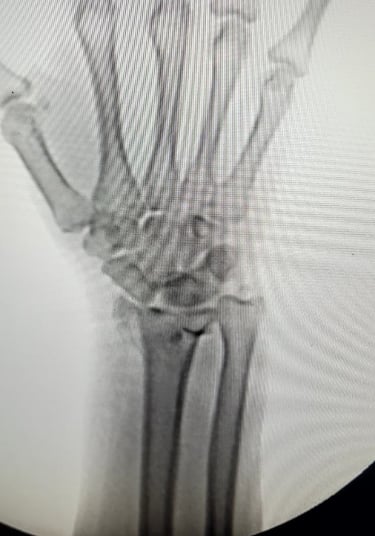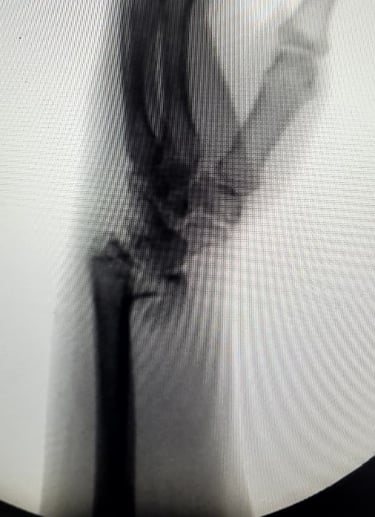Online & Home visit Consultation Available with Portable Home X-Ray facility available.
Consultation available on HINDI language also
Volar Barton Fracture – Causes, Symptoms and Treatment
A Volar Barton fracture is a specific type of wrist fracture involving the distal radius (the end of the forearm bone near the wrist joint) along with a dislocation or subluxation of the radiocarpal joint towards the palm (volar side). This injury affects not just the bone, but also the stability of the wrist joint, making it a serious condition that requires prompt medical attention.
Dr. M. Kalaivanan
8/19/20252 min read


Volar Barton Fracture – Causes, Symptoms, and Treatment
A Volar Barton fracture is a specific type of wrist fracture involving the distal radius (the end of the forearm bone near the wrist joint) along with a dislocation or subluxation of the radiocarpal joint towards the palm (volar side). This injury affects not just the bone, but also the stability of the wrist joint, making it a serious condition that requires prompt medical attention.
---
How It Happens (Mechanism of Injury)
Usually occurs due to a fall on an outstretched hand (FOOSH) when the wrist is in flexion.
Can also result from high-energy trauma such as road traffic accidents, sports injuries, or falls from height.
The impact drives the carpal bones into the distal radius, causing a fracture along with displacement of the joint.
---
Common Symptoms
Sudden pain and swelling on the front (palm side) of the wrist
Deformity or abnormal contour of the wrist joint
Restricted or painful movement of the wrist and hand
Bruising around the injury site
In severe cases, numbness or tingling in the fingers due to nerve compression
---
Diagnosis
Clinical Examination: To assess swelling, tenderness, deformity, and neurovascular status of the hand.
X-ray: Confirms the fracture pattern and joint involvement.
CT Scan (if needed): Gives detailed visualization of the fracture line, especially for surgical planning.
---
Treatment Options
Because a Volar Barton fracture involves joint instability, conservative treatment is rarely sufficient unless the fracture is completely undisplaced.
1. Non-Surgical (Conservative) Management:
For very stable, undisplaced fractures — immobilization in a below-elbow cast for 4–6 weeks.
Requires regular X-ray monitoring to ensure no displacement occurs.
2. Surgical Management:
Open Reduction and Internal Fixation (ORIF): The most common approach. A volar plate and screws are used to restore joint congruity and allow early wrist movement.
Surgery aims to realign the joint surface, restore wrist function, and prevent arthritis.
---
Complications if Untreated or Improperly Managed
Post-traumatic arthritis of the wrist
Chronic pain and stiffness
Weak grip strength
Permanent deformity and loss of wrist motion
---
Rehabilitation
Early physiotherapy is essential after surgical fixation to regain mobility.
Strengthening exercises and gradual return to daily activities help prevent stiffness and weakness.
Full recovery may take 3–6 months depending on severity and patient compliance.
---
Key Takeaway
A Volar Barton fracture is not just a simple wrist fracture — it’s a fracture-dislocation involving the joint. Because joint alignment is critical for long-term wrist function, early diagnosis and proper management by an orthopaedic specialist are crucial for the best outcome.
---


Get in touch
Sri Riddhi Specialty Clinic
Door no: 893, Kairasi Nagar, Rajiv Ghandhi Nagar Bustop, Vayalur Main Road, Natchikurichi, Tiruchirappalli - 620102
+91 99448 01540, +91 81220 73520
Consulting Hours
Monday- Saturday
05.30 PM-10.00 PM
On Sunday
Only on Appointment Basis
